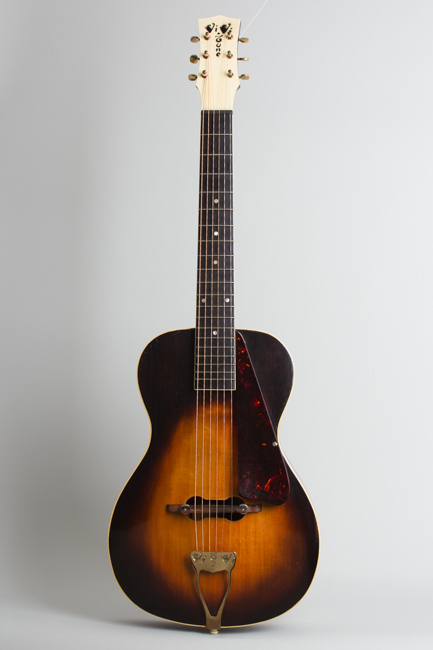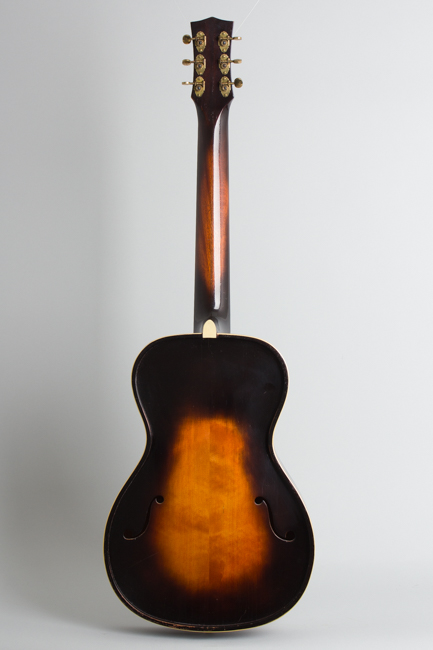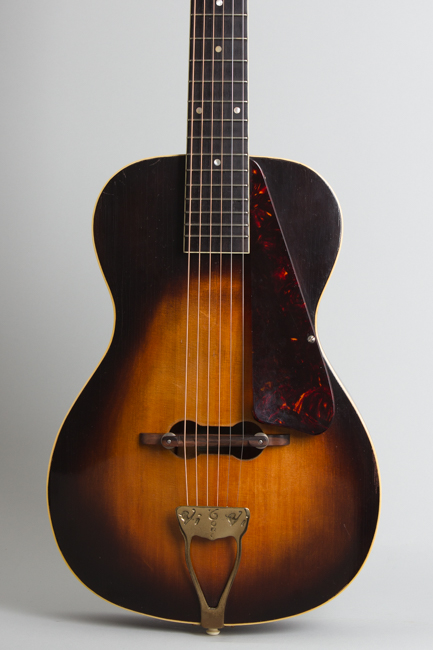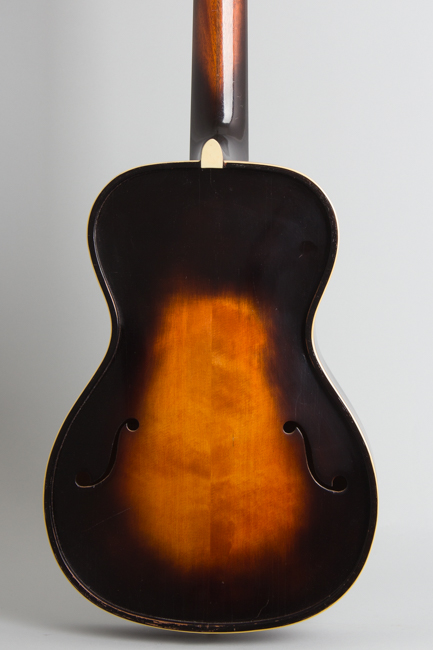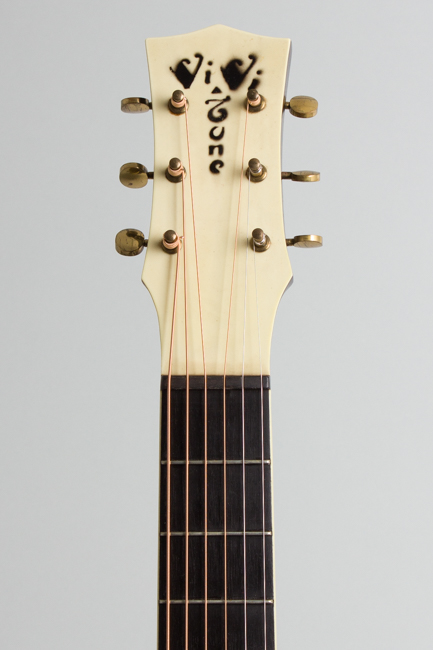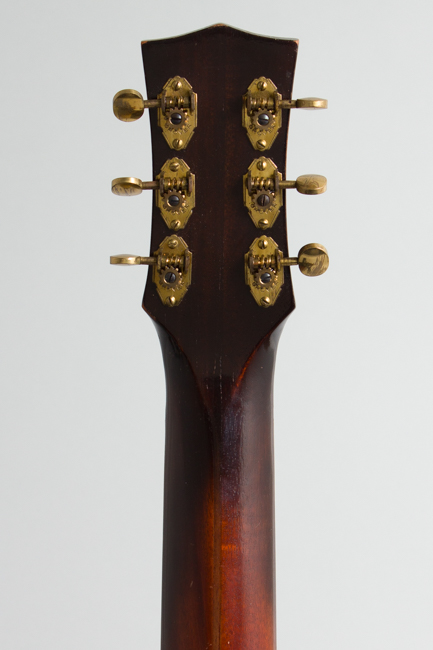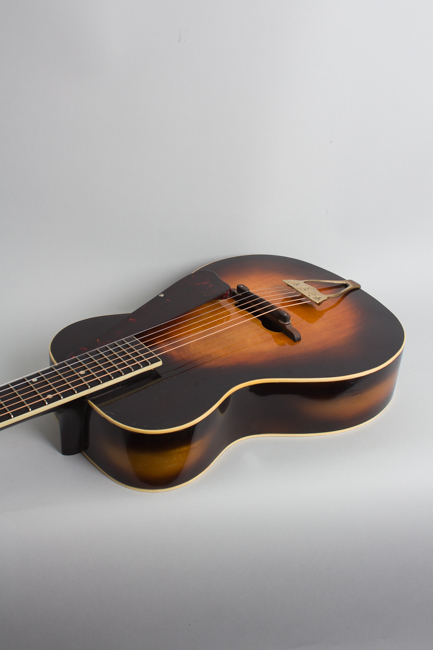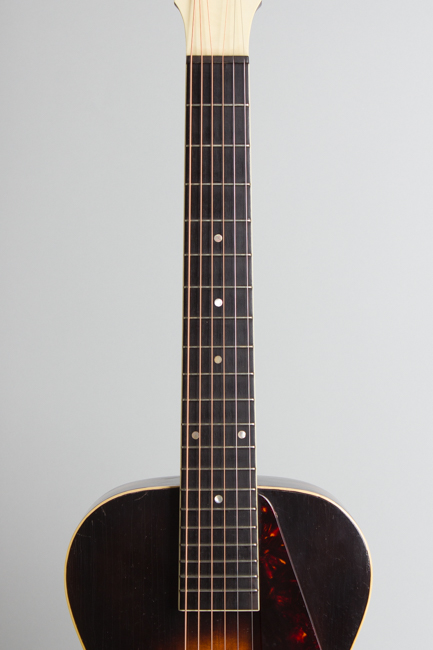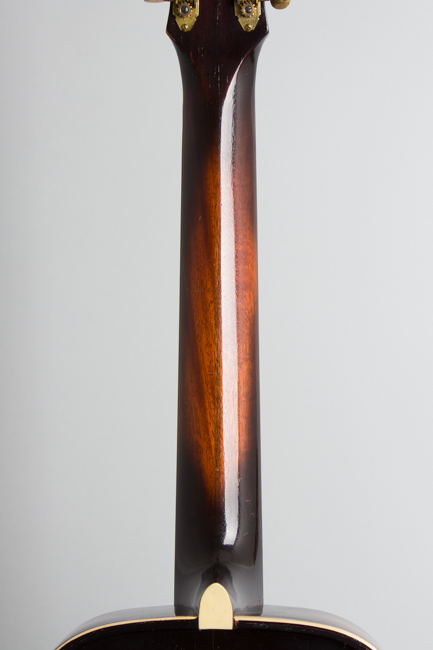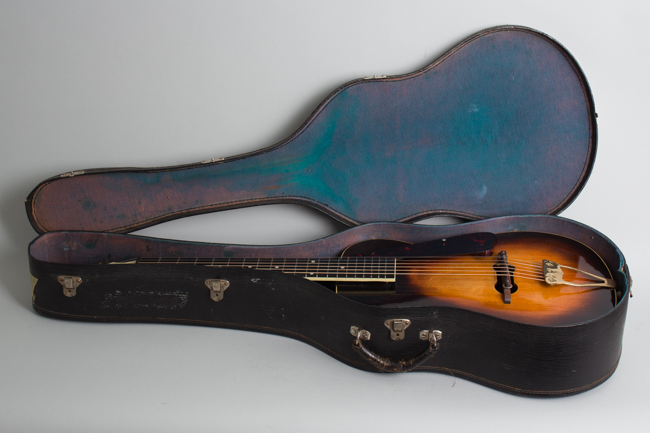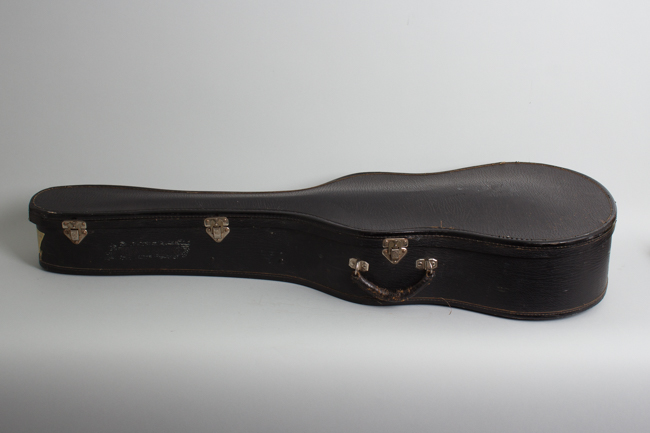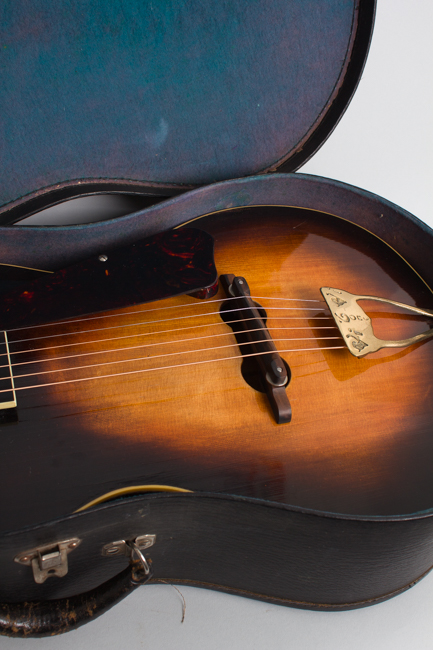Vivi-Tone Acousti-Guitar Acoustic Guitar (1936)
Vivi-Tone Acousti-Guitar Model Acoustic Guitar (1936), made in Kalamazoo, Michigan, serial # 587, sunburst finish, spruce top and back, maple sides, mahogany neck with ebony fingerboard, original black chipboard case.
This is a fairly late example of a Vivi-Tone "Acousti-Guitar", a truly unique creation sprung from the fertile imagination of acoustic engineer Lloyd Loar. Ten years on from his stint in Kalamazoo, Loar and former Gibson associate Lewis A. Williams launched the Vivi-tone company to market electric instruments. Unfortunately sales of these were so minimal they also soon proffered these "Acousti-Guitar" models for more conservative players (well maybe!) which embody the unusual fruits some of Loar's acoustic theories.
This radical instrument is one of the most distinctive fretted creations of the 1930's or any other time. It almost turns the guitar inside out; the arched solid spruce BACK is the soundboard as much as the spruce top. The laminated rims are very heavy to prevent any vibration, and the back is recessed into them to avoid contact with the player. The figure-8 soundhole in the top is under the substantial adjustable bridge, while the back carries two small f-holes. The neck is nearly 2" wide with a hefty "Soft V" shape and fitted with the company's "Fairy Action Frets" i.e. unusually high fretwire supposed to aid playability. The long elevated pickguard is very heavy tortoise celluloid on a wood frame.
This 1936 era Acousti-Guitar was built in the second generation of Vivi-Tone, by then under the stewardship of the Moon brothers in Detroit who had taken the faltering company over from Loar and Williams. The older subtle hand-rubbed sunburst on the top, back, and rims has given way to a less artful 'burst with a more reddish tint, but otherwise construction was little changed. The top, back and neck are single-bound in ivory celluloid. The striking Art Nouveau "Vivi-Tone" logo is screened onto the ivory celluloid headstock veneer and cast into the tailpiece. The tuners are individual metal-button Grovers; they and the tailpiece are gold plated.
A small blue label inside carries a very late serial # 587. An additional label reads "On or before the 6th day of January 1937 this acousti-guitar No. 587 if kept in good condition, may be exchanged at full prevailing price at time of exchange on an Acousti-Lectric Guitar for either acoustic or electric playing selling for not less than $99.00 retail. Vivi-Tone Company, Kalamazoo Michigan". This marks the instrument as having been sold in early 1936 (the deal was good for a year) and shows the company hoping the buyer would soon want to upgrade to the miracle of amplified sound. Sadly the electric revolution was well underway by 1936 and there were many electric guitars available with more efficient magnetic pickups and more conventional design than the eccentric Vivi-Tones.
The company only lasted a short time but left behind some of the most unique guitars ever built, both acoustic and electric. This Acousti-Guitar is nicely original with only the bridge being a reproduction and is in very nicely preserved condition. The sound is surprisingly loud for so small a guitar (Loar wasn't COMPLETELY out of his tree) and carries extremely well, perhaps most reminiscent of a roundhole archtop like a Gibson L-4. The "Fairy Action" frets feel odd, but when one gets used to then are fully functional. Although a blind alley in guitar evolution, this Vivi-Tone Acousti-Guitar is still a fascinating creation and truly unique musical personality, a genuine playable museum piece .
Overall length is 39 1/2 in. (100.3 cm.), 13 1/4 in. (33.6 cm.) wide at lower bout, and 3 7/8 in. (9.8 cm.) in depth, measured at side of rim. Scale length is 24 1/4 in. (616 mm.). Width of nut is 1 7/8 in. (48 mm.).
This nearly 90-year old guitar shows only light wear overall with no notable no damage or repair. The finish has only very minor scuffs and dings with no large areas of wear; likely nobody ever made much effort to play this unusual guitar! All the hardware is original except the bridge which is an exact repro down to the wire saddle on the underside for Hawaiian play. The gold plating is generally nicely preserved as well with a bit of loss to the tailpiece. The pickguard has a bit of upward warping but is still fully intact.
The original very high frets have virtually no wear and -- on its own terms -- this is a very playable guitar with a lot more sound than one might expect. While definitely a historical oddity, this is one of the most interesting and original acoustic guitars of the 20th century, if far from the best remembered! It still rests in the original heavy chipboard case. Overall Excellent Condition.
This is a fairly late example of a Vivi-Tone "Acousti-Guitar", a truly unique creation sprung from the fertile imagination of acoustic engineer Lloyd Loar. Ten years on from his stint in Kalamazoo, Loar and former Gibson associate Lewis A. Williams launched the Vivi-tone company to market electric instruments. Unfortunately sales of these were so minimal they also soon proffered these "Acousti-Guitar" models for more conservative players (well maybe!) which embody the unusual fruits some of Loar's acoustic theories.
This radical instrument is one of the most distinctive fretted creations of the 1930's or any other time. It almost turns the guitar inside out; the arched solid spruce BACK is the soundboard as much as the spruce top. The laminated rims are very heavy to prevent any vibration, and the back is recessed into them to avoid contact with the player. The figure-8 soundhole in the top is under the substantial adjustable bridge, while the back carries two small f-holes. The neck is nearly 2" wide with a hefty "Soft V" shape and fitted with the company's "Fairy Action Frets" i.e. unusually high fretwire supposed to aid playability. The long elevated pickguard is very heavy tortoise celluloid on a wood frame.
This 1936 era Acousti-Guitar was built in the second generation of Vivi-Tone, by then under the stewardship of the Moon brothers in Detroit who had taken the faltering company over from Loar and Williams. The older subtle hand-rubbed sunburst on the top, back, and rims has given way to a less artful 'burst with a more reddish tint, but otherwise construction was little changed. The top, back and neck are single-bound in ivory celluloid. The striking Art Nouveau "Vivi-Tone" logo is screened onto the ivory celluloid headstock veneer and cast into the tailpiece. The tuners are individual metal-button Grovers; they and the tailpiece are gold plated.
A small blue label inside carries a very late serial # 587. An additional label reads "On or before the 6th day of January 1937 this acousti-guitar No. 587 if kept in good condition, may be exchanged at full prevailing price at time of exchange on an Acousti-Lectric Guitar for either acoustic or electric playing selling for not less than $99.00 retail. Vivi-Tone Company, Kalamazoo Michigan". This marks the instrument as having been sold in early 1936 (the deal was good for a year) and shows the company hoping the buyer would soon want to upgrade to the miracle of amplified sound. Sadly the electric revolution was well underway by 1936 and there were many electric guitars available with more efficient magnetic pickups and more conventional design than the eccentric Vivi-Tones.
The company only lasted a short time but left behind some of the most unique guitars ever built, both acoustic and electric. This Acousti-Guitar is nicely original with only the bridge being a reproduction and is in very nicely preserved condition. The sound is surprisingly loud for so small a guitar (Loar wasn't COMPLETELY out of his tree) and carries extremely well, perhaps most reminiscent of a roundhole archtop like a Gibson L-4. The "Fairy Action" frets feel odd, but when one gets used to then are fully functional. Although a blind alley in guitar evolution, this Vivi-Tone Acousti-Guitar is still a fascinating creation and truly unique musical personality, a genuine playable museum piece .
Overall length is 39 1/2 in. (100.3 cm.), 13 1/4 in. (33.6 cm.) wide at lower bout, and 3 7/8 in. (9.8 cm.) in depth, measured at side of rim. Scale length is 24 1/4 in. (616 mm.). Width of nut is 1 7/8 in. (48 mm.).
This nearly 90-year old guitar shows only light wear overall with no notable no damage or repair. The finish has only very minor scuffs and dings with no large areas of wear; likely nobody ever made much effort to play this unusual guitar! All the hardware is original except the bridge which is an exact repro down to the wire saddle on the underside for Hawaiian play. The gold plating is generally nicely preserved as well with a bit of loss to the tailpiece. The pickguard has a bit of upward warping but is still fully intact.
The original very high frets have virtually no wear and -- on its own terms -- this is a very playable guitar with a lot more sound than one might expect. While definitely a historical oddity, this is one of the most interesting and original acoustic guitars of the 20th century, if far from the best remembered! It still rests in the original heavy chipboard case. Overall Excellent Condition.
